| Title | Description | Location | Lead |
|---|---|---|---|
A Change of Seasonality of the Upper Arctic Ocean in Response to Atmospheric and Sea Ice Forcing |
The PI proposes to investigate the change of seasonality of the Arctic Ocean Ekman transport and upwelling/downwelling, and their relationships to key components of the arctic system. A systematic investigation of the Arctic Ocean upwelling and its change of seasonality is needed in order to understand complex interactions among components of a rapidly changing arctic system. Upwelling is arguably the single most important dynamical variable in oceanography. It forces oceanic gyres through the Sverdrup balance. Upwelling replenishes nutrients in the surface layer and helps to sustain |
Principal Investigator
Jiayan Yang
Woods Hole Oceanographic Institution (WHOI)
|
|
A Purpose-Driven Merger of Western Science and Indigenous Knowledge of Water Quality in Alaskan Communities |
Project AbstractThe well-being of Alaskan Indigenous communities depends on access to safe drinking water. However, water pollution has remained a reality for many of these communities due to naturally occurring and anthropogenic pollutants. As the climate warms, environmental changes will likely exacerbate water contamination problems by releasing entombed microorganisms, ancient organic carbon, nutrients, and metals through thawing of permafrost and melting of glaciers. While Alaskan communities are highly vulnerable to such changes, they also hold valuable Indigenous Knowledge about |
Anchorage, AK; Selawik, AK |
Principal Investigator
Navid Saleh
University of Texas at Austin
|
Accelerating Discoveries at Greenlands Marine Margins Through International Collaboration |
Project AbstractMost of Greenland is covered by the expansive Greenland Ice Sheet, which, if it all melted, would cause sea level to rise by more than 20 feet. Greenland has been losing ice at a particularly rapid rate since the mid-1990s, with impacts for local and global fisheries. This AccelNet project (GRISONET) is designed to facilitate rapid and effective collaboration-building and foster discovery about the Greenland ice sheet, the ocean, the marine ecosystems and their interactions. GRISONET will address current knowledge gaps and community-identified needs by establishing |
University of Texas at Austin |
Principal Investigator
Fiamma Straneo
Scripps Institution of Oceanography
|
Adaptable Microgrids in Arctic Communities |
Project AbstractArctic communities currently face environmental and economic changes that threaten their way of life. New ways of designing and building electric power systems might help these communities meet these challenges now and in the future. The goal of this research is to address these challenges by bringing together researchers, rural Alaska energy experts, and local people living in the Arctic. These groups are identifying needs and designing research on less expensive, portable, and renewable energy-based electric systems to address changing conditions. The adaptable |
Anchorage, AK; Northern, AK |
Principal Investigator
Kristen Schell
Rensselaer Polytechnic Institute
|
Adaptive Capacity and Resilience in the New Arctic: Identifying Pathways to Equitable, Desirable Outcomes for People and Nature Through Convergence |
Project Abstract:
|
Fairbanks, AK; Lincoln, NE |
Principal Investigator
Craig Allen
University of Nebraska
|
Alaska Arctic Observatory and Knowledge Hub (AAOKH) |
We provide resources and scientific information for sharing expertise and observations of Alaska sea ice, wildlife, and coastal waters. |
Kotzebue, Point Hope, Wainwright, Utqiaġvik, and Kaktovik, Alaska |
Project Contact
Donna Hauser
University of Alaska Fairbanks
|
Alaska Bee Atlas |
The Alaska Bee Atlas is a collaborative program to collect bees and associated habitat data across Alaska. The program primarily uses the support of federal and state biologists who are already in the field collecting data for other projects. To date the data have provided significant understanding of the biodiversity of bees in Alaska and have documented over a dozen new species to the state. The Alaska Bee Atlas is managed by the Alaska Center for Conservation Science (ACCS) at the University of Alaska Anchorage. THe AK Bee Atlas was developed by ACCS and the Bureau of Land Management (BLM) |
Project Contact
Justin Fulkerson
Alaska Center for Conservation Science
|
|
Alaska Invasive Species Partnership |
Vision Statement:
|
University of Alaska Fairbanks |
Project Contact
Tammy Davis
Alaska Department of Fish and Game
|
Analysis and Attribution of Changes in Siberian Hydroclimate and Implications for the Future |
This work will document observed changes in the hydroclimatology of the Siberian region, attribute these changes to specific physical mechanisms in the context of climate change, and study the impact of those changes from the regional to the hemispheric weather and climate. The project will use observational analysis and modeling experiments to investigate the links between arctic sea ice trends and changes to seasonal snow cover. The autumn snow cover is of particular interest due to its persistent increases over the last two decades despite the robust warming trend and its connection to |
Principal Investigator
Judah Cohen
Atmospheric and Environmental Research, Inc.
|
|
Arctic Impacts and Reverberations of Expanding Global Maritime Trade Routes |
Project Abstract
|
Utqiagvik, Alaska; Port of Nome; Northern Alaska |
Principal Investigator
Elise Miller-Hooks
George Mason University
|
Arctic Network for Coastal Community Hazards, Observations, and Integrated Research (ANCHOR) |
Project Abstract
|
Hooper Bay, AK; Coastal Alaska |
Principal Investigator
Thomas Ravens
University of Alaska Anchorage
|
Arctic Robust Communities-Navigating Adaptation to Variability (ARC-NAV) |
Project AbstractThe Arctic is warming on average twice as rapidly as the rest of the planet, which is leading to significant changes in sea ice to which local communities must respond. Beringia, a region of the Arctic encompassing US and Russian territory, is expected to experience some of the highest variability in sea ice conditions in the coming century. This project focuses on the question: how do we design better and more flexible governance and infrastructure to adapt to changing Arctic conditions? To answer this question, the team is taking a convergence approach to forecast |
Gambell, AK; Point Hope, AK; Nome, AK; Utqiaġvik, AK; Paratunka, Russia; Sireniki, Russia; Pakhachi, Russia |
Principal Investigator
Tatiana Degai
University of Northern Iowa
|
Arctic Surface Air Temperatures for the Past 100 years: Analysis and Reconstruction of an Integrated Data Set for Arctic System Science |
The Arctic has long been considered a harbinger of global climate change since increases in surface air temperature (SAT) over the globe are amplified in the Arctic. These increases in SAT have a profound impact on many other aspects of Arctic climate and ecology. For example, the thinning and decrease in area of Arctic sea ice has been attributed to increases in SAT, and many plant and animal species have been migrating further north.
|
Lead Principal Investigator
Ignatius Rigor
Polar Science Center, APL/UW
|
|
Arctic systems and seasons: Braiding culture, art, STEM, and community through year-round Arctic citizen science |
Overview
|
Lead Scientist
Katie Spellman
University of Alaska Fairbanks, International Arctic Research Center
|
|
Arctic Urban Risks and Adaptations (AURA): a Coproduction Framework for Addressing Multiple Changing Environmental Hazards |
Project Abstract
|
Anchorage, Alaska; Fairbanks, Alaska; Whitehorse, Yukon |
Principal Investigator
Jennifer Schmidt
UAA Institute of Social and Economic Research (ISER)
|
Atautchikkun Ilitchisukluta (Coming together to learn): Co-producing knowledge across the Northwest Passage |
Project Abstract
|
Utqiaġvik, AK |
Principal Investigator
Courtney Carothers
University of Alaska Fairbanks
|
Atmospheric Measurements from Unmanned Aircraft during SODA - Deployment of miniFlux and Initial Data Analysis |
Project AbstractUnderstanding the temperature structure of the upper ocean in the Arctic is very important for properly simulating the formation and melt of sea ice in climate and weather models. The presence (or absence) is important for a variety of activities, including shipping, energy exploration, and hunting by Native populations. Therefore, forecasting the presence of ice at shorter timescales is critically needed. Sea ice additionally has a controlling influence on climate by acting as a bright surface capable of reflecting sunlight back to space, thereby highlighting a need to |
Oliktok Point, AK |
Principal Investigator
Gijs de Boer
University of Colorado Boulder
|
Bridging the Atomistic Deformation Mechanisms to the Microscopic Adhesive-to-Cohesive Fracture at the Ice-Metal Interfaces |
Project Abstract
|
No field location |
Principal Investigator
Liming Xiong
Iowa State University
|
Central North Atlantic Marine Historical Ecology Project |
Project AbstractAtlantic cod has been an important resource for coastal and inland communities throughout the Atlantic world for at least 1000 years. This humble fish played an important role in feeding communities, developing markets, and facilitating trade and continues to be a vitally important species. Management decisions made about existing cod populations are based on scientist's ideas of what a baseline "normal" or "natural" cod population is. This baseline for cod is mostly based on data from the last 100-150 years, including how large cod populations have been, how large the |
Central North Atlantic; Iceland |
Principal Investigator
Nicole Misarti
University of Alaska Fairbanks
|
Changing Seasonality of the Arctic: Alteration of Production Cycles and Trophic Linkages in Response to Changes in Sea Ice and Upper Ocean Physics |
Significant changes in the arctic environment have been detected in recent years. One of the most striking changes is the decline of arctic sea ice. A diminished arctic ice cover may have a profound effect on all components of the marine ecosystem. Despite the extreme polar conditions, the Arctic Ocean supports a complex pelagic food web that includes zooplankton, fish, birds, seals, walruses, whales and the top predator, the polar bear. At the base of the food chain, supporting all the marine life, are the phytoplankton and algae that produce organic carbon. The central hypothesis of this |
Principal Investigator
Jinlun Zhang
University of Washington
|
|
Climate Response to Future Changes in Arctic Snow Cover and Sea Ice: A New Perspective from the High-Resolution NCAR CCSM3 |
Intellectual Merit: The PI's propose to investigate the impact of projected future changes in Arctic sea ice (extent, concentration and thickness) and snow cover (extent and depth) upon the global atmospheric circulation, the oceans, and surface climate using the new high-resolution (T85) version of the NCAR Community Climate System Model Version 3 (CCSM3).
|
Lead Principal Investigator
Clara Deser
University Corporation for Atmospheric Research
|
|
Closing the Water Vapor Exchange Budget Between the Ice Sheets and Free Atmosphere |
Project AbstractAs the Arctic warms faster than the rest of the planet, understanding the Greenland ice sheet response to changing climate—and the associated effect on sea level rise—is important for policy and mitigation strategies. A variety of satellite and surface tools currently exist to help understand snow accumulation and the loss of ice from outlet glaciers or melting, but the magnitude of water vapor exchange between the interior ice sheet and the atmosphere remains essentially unknown. This vapor flux could potentially be a very large factor in calculating the mass gain or |
Greenland |
Principal Investigator
Bruce Vaughn
Institute of Arctic and Alpine Research, University of Colorado Boulder
|
Co-Production of Shorefast Ice Knowledge in Uummannaq Bay, Greenland |
Project Abstract
|
Uummannaq Region of West Greenland |
Principal Investigator
Jonathan Ryan
Brown University
|
Collaborative Research on Sunlight and the Arctic Atmosphere-Ice-Ocean System |
The distinct annual cycle of solar radiation is a key defining feature of the Arctic system. The lack of sunlight in winter and the long daylight hours in summer structure both terrestrial and marine ecosystems, drive the seasonal build-up and sequestration of carbon and control the annual cycle of the surface heat budget. Recent research has also demonstrated that the seasonal photochemistry of snow over sea ice plays a major role in the cycling of major atmospheric constituents. One of the most important aspects of the disposition of solar radiation within the Arctic system is the reflection |
Lead Principal Investigator
Donald Perovich
Cold Regions Research and Engineering Laboratory (CRREL)
|
|
Collaborative Research: A Heat Budget Analysis of the Arctic Climate System |
The Arctic System can be viewed as a set of interconnected and interacting physical, biological and human components. Arguably the most integrating component of the full Arctic system is its climate system. The mean state, variability and change in the climate system exert strong controls on biological processes and human activities. Arctic climate is in turn tightly coupled to the global system. This is an effort towards synthesis of the Arctic climate system that distills the wealth of data assembled though ARCSS and other national and international efforts in a tractable, integrating heat |
Lead Principal Investigator
Mark Serreze
National Snow and Ice Data Center (NSIDC)
|
|
Collaborative Research: A Synthesis of Rapid Meltwater and Ice Discharge Changes: Large Forcings from the Ice with Impacts on Global Sea Level and North Atlantic Freshwater Budgets |
Freshwater discharge from the Greenland ice sheet has a direct and immediate effect on global sea level, has the potential to impact global climate by perturbing nearby sensitive regions of oceanic deep-water formation, and is an important but as yet poorly quantified part of the pan-Arctic water balance.
|
Lead Principal Investigator
|
|
Collaborative Research: Greening of the Arctic - Synthesis and Models to Examine the Effects of Climate, Sea-ice, and Terrain on Circumpolar Vegetation Change |
Changes to the vegetation of the Arctic are intimately linked to changes to the sea-ice cover, land surface temperatures, and a host of terrain variables. The overarching goals of this research are to (1) explore the sea-ice/terrain/vegetation linkages by synthesizing a group of recently available long-term circumpolar databases, (2) examine how the vegetation of the circumpolar Arctic is responding to global climate change, and (3) use this information in combination with models to help predict future response of arctic vegetation. The project will address directly the question of how the |
Lead Principal Investigator
|
|
Collaborative Research: Humans and Hydrology at High Latitudes |
Data for the dynamics, uses and values of freshwater in the Arctic are rapidly accumulating. However, it is currently unknown which regions of the pan-Arctic are most vulnerable to future changes. In order to begin to address the future change to freshwater availability on a pan-arctic scale, this team will use a system of arctic typologies to enable the integration of biophysical data with socio-cultural data produced regionally, such as demographics and water values. They will use mature data sets to study the strategic transformations of the high latitude water cycle.
|
Lead Principal Investigator
Richard Lammers
University of New Hampshire
|
|
Collaborative Research: Synthesis of Arctic System Carbon Cycle Research Through Model-Data Fusion Studies Using Atmospheric Inversion and Process-Based Approaches |
A large release of CO2 and CH4 from high latitude terrestrial and marine systems to the atmosphere has the potential to affect the climate system in a way that may accelerate global warming. To improve our ability to predict the dynamics of carbon in high latitudes, this team will analyze comprehensively the carbon cycle of the arctic system, guided by the following general questions: What are the geographic patterns of fluxes of CO2 and CH4 over the Pan-Arctic region and how is the balance changing over time and; What processes control the sources and sinks of CO2 and CH4 over the Pan-Arctic |
Lead Principal Investigator
A. David McGuire
University of Alaska Fairbanks
|
|
Collaborative Research: Synthesis of Modes of Ocean-Ice-Atmosphere Covariability in the Arctic System from Multivariate Century-Scale Observations |
The project is an integrated statistical analysis of a comprehensive set of long time series from the Arctic and subpolar North Atlantic. These multivariate records include meteorological and oceanographic measurements, sea ice observations and climate indices. The project data set will comprise: a subset of the multidecadal to century-scale ‘Unaami’ Data Collection, and a set of relatively unknown, century-scale time series from the subpolar North Atlantic (Nordic Seas, Greenland, Iceland, Faroe Islands and Norway) and Arctic that is new to the US community.
|
Lead Principal Investigator
Martin Miles
INSTAAR, University of Colorado - Boulder
|
|
Community collective action to respond to climate change influencing the environment-health nexus |
How are communities and individual organizations responding to the health impacts of climate change? A global research team from University College London, University of Norway, and University of West Indies have partnered with the Sitka Sound Science Center and the RAND cooperation to learn about the successes and failures organizations face when tackling the health related impacts of climate change. Through a series of community interviews researchers will study topics related to food security, food sovereignty, and more!
|
Sitka, Alaska |
Project Contact
Lisa Busch
Sitka Sound Science Center
|
Coordinate a Transdisciplinary Research Network to Identify Challenges of and Solutions to Permafrost Coastal Erosion and Its Socioecological Impacts in the Arctic |
Project Abstract
|
Fairbanks, AK; Anchorage, AK |
Principal Investigator
Ming Xiao
Penn State University
|
Current and Future Arctic Community Vulnerabilities to Sea-Ice Change and Economic Expansion |
Project AbstractArctic communities are experiencing unprecedented transformation due to environmental changes and expanding and intensifying economic development. For example, as the climate warms, sea ice becomes thinner and less extensive, which enables the expansion of global trade and more shipping traffic with larger ships. This project is investigating the impacts of rapidly changing sea ice conditions on Arctic communities, how these changes interact with social and economic threats, and how the socio-economic and other contexts of the communities affect their vulnerabilities to |
Aasiaat, Greenland; Chersky, Russia; Alert Bay, Canada |
Principal Investigator
Laura Landrum
National Center for Atmospheric Research
|
Developing an Understanding and Predictive Capability of the Interconnections Among Arctic Terrestrial, Atmospheric, and Marine Systems |
Most regional observation networks indicate that dramatic changes have occurred across the Arctic in recent decades, but comparatively little work has been done to assess atmospheric and oceanic responses to the dramatic observed terrestrial changes. Both increases in surface air temperature and a shift in arctic air circulation patterns are likely to contribute to changes in ice distribution. Rising sea level, changes in coastal geography due to shoreline erosion, increased winds, storm surges, and flooding may be the direct results of the depletion of sea ice and the resulting increase in |
Lead Principal Investigator
Walter Oechel
San Diego State University
|
|
Developing Arctic Resilience to Future Water Cycle, River Systems, and Coastal Change |
Project Abstract
|
Kotzebue, AK; YK Delta, AK; Coastal, AK |
Principal Investigator
Julie Brigham-Grette
University of Massachusetts, Amherst
|
Developing Coordinated Monitoring Networks in the Arctic to Evaluate and Respond to Rapidly Changing Environments |
Project AbstractIn the Arctic where, environmental conditions are rapidly changing, the need to monitor these changes is critical to inform natural resource management and land management, protect built infrastructure, reduce risk to human lives, and enhance community resilience for Arctic communities. Currently in Alaska and northern Canada there exist numerous environmental monitoring programs that are led and implemented by a diverse array of indigenous communities, government agencies, and research institutions, often with little coordination or connection to one another. Led by a |
Coastal British Columbia; Anchorage, AK; Fairbanks, AK; Whitehorse, Canada; Yellowknife, Canada |
Principal Investigator
Leanna Heffner
Northwest Boreal Landscape Conservation Cooperative
|
Diamonds and Oil from the Tundra: A System Study on the Impact of Changing Seasons on Mining and Oil Exploration |
Natural resource extraction is the backbone of the arctic economy. Oil and gas exploration and production taxes account for 88% of the State of Alaska’s revenue, providing $10.2 billion in fiscal year 2008. In addition, 4,400 direct and 37,344 indirect Alaskan jobs are due to this industry. In Canada, oil and gas are also crucial to the economy, but so too is diamond mining, with a total value of diamond extraction in the Northwest Territories of $2 billion in 2007. As a result, Canada is the 3rd largest diamond producer in the world. The mines employ about 4,000 people, roughly 35% of whom |
Principal Investigator
Matthew Sturm
University of Alaska Fairbanks
|
|
Dynamic Vehicle-Terrain Modeling and Control of Lightweight Ground Robots in Snow and Sand |
Project Abstract
|
Hanover, NH |
Principal Investigator
Laura Ray
Dartmouth College
|
Effects of Lengthening Growing Season and Increasing Temperature on Soil Carbon Fluxes and Stocks in Arctic Tundra |
This one-year pilot project supports PI to test a new soil respiration measurement method and the possibility to manipulate temperature in the Arctic tundra. We warmed the tundra ecosystems with open-top chambers, conducted trenching experiment, and measured soil respiration with the continuous CO2 profile system.
|
Principal Investigator
Jianwu (Jim) Tang
Marine Biological Laboratory
|
|
Effects of Warming-Induced Increases in Shrub Abundance and Changing Seasonality on Migratory Songbirds in Alaskan Arctic Tundra |
Our project extends beyond changes in vegetation, and considers the cascade of changes that is triggered when Arctic vegetation and seasonality are altered. As highlighted by the Arctic Climate Impact Assessment (ACIA), in contrast to plants, the response of animal populations to simulated or current climate changes has been drastically understudied in the Alaskan interior and much of the Arctic. We were funded by the US National Science Foundation’s Office of Polar Programs (NSF-OPP) for five years (2010-2014), to study the effects that warming-induced increases in shrub abundance and |
Principal Investigator
Natalie Boelman
Columbia University
|
|
Emergency Response in the Arctic (ERA): Investments for Global Capacities and Local Benefits |
Project Abstract
|
Nome, AK; Utqiaġvik, AK; Kotzebue, AK; Coastal AK |
Principal Investigator
Thomas Sharkey
Rensselaer Polytechnic Institute
|
Environmental Variability, Bowhead Whale Distributions, and Inupiat Subsistence Whaling: Whaling Linkages and Resilience of an Alaskan Coastal System |
The coupling between atmosphere, sea ice, ocean, bowhead whales, and subsistence whaling by the Native human populations is fundamental to the physical-biological-human systems of the Northern Alaska Coast. Whale migration routes and habitat use are determined by zooplankton aggregations, which are driven by oceanographic conditions, which depend on the climatic regime. Successful hunting depends on interactions between environmental and societal factors that vary each year and are driven by forces originating outside the system. This complex suite of environment-whale-human factors comprises |
Barrow, Alaska |
Lead Principal Investigator
Carin Ashjian
Woods Hole Oceanographic Institution
|
Exploring The Benefits and Challenges of Community-Powered Connectivity In The New Arctic |
Project AbstractArctic telecommunications has emerged as a key tool in responding to the unprecedented changes being experienced in the region, from environmental shifts to globalization. Unfortunately, small rural and Indigenous communities are seldom included in discussions of telecommunications, leaving them underserved and incapable of leveraging technology advances to ensure their own resilience. This project is developing a model that small Arctic communities can use to design and implement community technology infrastructure to support their unique needs. Findings advance |
Ulukhatok, Canada |
Principal Investigator
Kurtis Heimerl
University of Washington
|
Exploring the Potential of Digital Education Frameworks to Build Understanding of Socioecological Impacts of Alaskan Environmental Change |
Project AbstractAs the Arctic warms, social and environmental changes threaten the Arctic, its inhabitants, and their ways of life. Mitigating the effects of these changes must include educating young people about the complex interactions involved since their generation will experience the growing impacts over time. Many science concepts, such as rising temperatures and carbon dioxide levels, are challenging to teach and understand because they are literally invisible, while their effects, such as salmon killed by the heat stress of warming water, are all too visible. This project is |
Fairbanks, AK |
Principal Investigator
Bill Shribman
WGBH
|
Facilitating Increased Engagement Between the Research Communities of Greenland and the US |
Project Abstract
|
Nuuk, Greenland |
Principal Investigator
Lauren E. Culler
Dartmouth/ARCUS Board
|
Flora of Alaska Project |
A flora is a compilation of information about the plant taxa that occur in a region. Information in a flora includes taxonomic names, histories of name usage, descriptive materials of the characteristics of taxa (e.g. keys, descriptions, illustrations, and photographs), spatial extent of taxa, specimen lists, and other relevant data. Because taxonomic information constantly changes as the result of exploration and research, the usefulness of floras decreases with time. The last comprehensive floras for Alaska were published by Eric Hultén in 1968 and Stanley Welsh in 1974. A new Flora of |
University of Alaska Fairbanks |
Project Contact
Stefanie Ickert-Bond
University of Alaska Fairbanks
|
Flux and Transformation of Organic Carbon across the Eroding Coastline of Northern Alaska |
Terrestrial arctic ecosystems store 25.33% of the world's soil organic carbon (OC), and large amounts of the long-sequestered OC is rapidly released by erosion along the ~2000 km coastline of northern Alaska. This eroded OC becomes available for biogeochemical cycling and makes a substantial, but poorly known, contribution to marine ecosystems and to CO2 and methane emissions to the atmosphere; released OC can potentially alter biogeochemical cycling, increase CO2 and methane emissions, contribute to climate warming, accelerate sea ice retreat, increase fetch and wave energy to exposed coasts |
Lead Principal Investigator
Chien-Lu Ping
University of Alaska Fairbanks
|
|
Foundations for Improving Resilience in the Energy Sector against Wildfire on Alaskan Lands (FIREWALL) |
Project AbstractDestructive wildfires in the Arctic, which are projected to grow in increased frequency and magnitude, are driven by multifaceted factors such as environmental change, expanded wildland-human interface, and lack of models to integrate natural, engineering, and social sciences to help coordinate response and recovery decisions. The interaction between the energy network and wildfires is highly interrelated since wildfires are compounded directly and indirectly by inaccurate and imprecise management of the energy network. The situation becomes further complicated in Arctic |
Alaska |
Principal Investigator
Mohammad Heidari Kapourchali
University of Alaska Anchorage
|
Fresh Eyes on Ice |
Winter is a rapidly changing season in the Arctic, causing widespread responses in freshwater ice and the ecosystems and communities that rely on frozen lakes and rivers.
|
University of Alaska Fairbanks |
Project Contact
Chris Arp
University of Alaska Fairbanks
|
Global Impacts and Social Implications of Changing Thermokarst Lake Environments Near Yukon River Watershed Communities |
Project AbstractObservations and modeling suggest the globe is standing on the inflection point of abrupt permafrost change. Increased methane emissions from newly formed lakes in melting permafrost regions likely play a major role in global climate. Reduction in permafrost and associated landscape change increasingly place Arctic and global communities at risk. Hence, improved forecasts for planning are critically needed. This project brings Alaskan communities together with social and natural scientists to examine changes in permafrost thaw lake environments, including the effects on |
Yukon River Watershed |
Principal Investigator
Tyler Jones
Institute of Arctic and Alpine Research / University of Colorado Boulder
|
Global Learning and Observations to Benefit the Environment (GLOBE) Alaska |
GLOBE is an international science and education program that provides students and the public worldwide with the opportunity to participate in data collection and the scientific process, and contribute meaningfully to our understanding of the Earth system and global environment.
|
University of Alaska Fairbanks |
Project Contact
Elena B Sparrow
University of Alaska Fairbanks International Arctic Research Center
|
Greenland Rising: Predicting Coastal Responses to a Changing Greenland Ice Sheet |
Project Abstract
|
Nuuk, Greenland; Kullorsuaq, Greenland; Aasiaat, Greenland; Tasiilaq, Greenland |
Principal Investigator
Robin Bell
Lamont-Doherty Earth Observatory (Columbia University)
|
Groundwater Treatment, Delivery and Use in Rural Alaska |
Project AbstractGroundwater is a key drinking water source in Alaska. However, groundwater in Alaska is commonly contaminated with naturally occurring metals including iron, manganese, and arsenic. When these contaminants are present in drinking water, they pose a serious health threat. Water treatment systems in many rural communities are not always able to remove these contaminants. This situation endangers the well-being of the community, diminishes trust in the treatment system, and reduces use of the treated water. The goal of this project is to address challenges involved with |
Anchorage, AK; Bethel, AK |
Principal Investigator
Rebecca Neumann
University of Washington
|
Halomethane Gas Exchange in Northern Alaskan Coastal Ecosystems |
Coastal ecosystems are believed to be globally important sources of methyl halides (CH3Br, CH3Cl, and CH3I) to the atmosphere, but fluxes from the arctic coastal zone have not yet been measured. CH3Br and CH3Cl are the dominant carriers of bromine and natural chlorine to the stratosphere, where they catalyze the destruction of ozone. CH3Br is also a widely used agricultural fumigant whose use is regulated by international agreement. CH3I is involved in tropospheric ozone chemistry and aerosol production and is a potential replacement fumigant for CH3Br. Our understanding of the tropospheric |
Lead Principal Investigator
Robert Rhew
University of California, Berkeley
|
|
Hearts in the Ice |
Hearts in the Ice was created to deepen our understanding of how powerful individual action can be, to add to our knowledge around climate change and what we each can do!
|
Longyearbyen, Norway |
Project Contact
Sunniva Sorby
Hearts in the Ice
|
Heterogeneity and Resilience of Human-Rangifer Systems: A Circumpolar Social-Ecological Synthesis |
The Human-Rangifer System is defined at the regional scale as the set of ecological-social processes underlying the human use of Rangifer. These processes include bio-physical interactions, socio-economic dynamics, the role of social institutions and organizations in shaping human adaptation. Resilience in these systems is the amount of disturbance to individual or multiple components that can be accommodated without change to alternative domains.
|
Lead Principal Investigator
Gary Kofinas
University of Alaska Fairbanks
|
|
How Does Changing Seasonality Affect the Capacity of Arctic Stream Networks to Influence Nutrient Fluxes from the Landscape to the Ocean? |
Stream networks are intimately connected to the landscapes through which they flow and significantly transform nutrients and organic matter that are in transport from landscapes to oceans. In previous research we studied several arctic headwater streams to determine how the seasonal development of the thaw basin (thawed sediments under streams) interacts with the hyporheic zone (a layer of surface sediments that contains water which exchanges continuously with water in the open channel). During this study we measured significant rates of net N and P regeneration from (or uptake by) the |
Principal Investigator
William Bowden
University of Vermont
|
|
How the Timing of Summer Precipitation Affects the Responses of Boreal Forest to Climate Change |
There is increasing evidence that ecological processes at high latitude are just as sensitive to the timing of events as to their magnitudes. In the boreal forest, moisture availability in summer affects both tree growth and the fire regime. Summers are brief and seasonal transitions rapid, so even slight shifts in the timing of precipitation patterns can have large impacts. One of the most striking seasonal phenomena in the Alaskan boreal forest is the onset of frequent frontal storms in late summer. This event usually comes in mid-July but is delayed into August or even September in some |
Principal Investigator
Appalachian Mountain Club
|
|
Impacts of the Changing Seasonality of Wind-Driven Mixing on the Arctic System |
The Arctic is generally considered a very quiet ocean. The sea ice impedes the generation and damps both surface and internal waves - and mixing rates in the water column are consequently generally very small. When we start looking at specific events in more detail, however, we found that when there is no ice the Arctic Ocean is actually a pretty active ocean. Storms generate intense of inertial motions throughout the water column. These motions affect the stratification and the vertical distribution of properties in the water column. We believe that this is a key factor in understanding the |
Principal Investigator
|
|
Indigenous Sentinels Network |
The Indigenous Sentinels Network is a tool for recording and communicating significant environmental and ecological events in order to empower remote communities dealing with the effects of climate change (i.e., environmental declines, economic disruptions for both subsistence and cash economies, loss of cultural knowledge, etc.). ISN uses the approach of an internet-based system (i.e., online database, smartphone or template apps, etc.) that enables communities across Alaska and beyond to implement rigorous monitoring programs while utilizing ISN’s well-refined environmental database.
|
Aleut Community of St. Paul Island |
Project Contact
Lauren Divine
Aleut Community of St Paul Island
|
Innovations in Energy Technologies and Empowerment in Arctic Fishing Communities |
Project AbstractCold Arctic conditions, twenty-four-hour summer sunlight combined with twenty-four-hour winter darkness, and a frozen ocean coastline for much of the year are threatening survival of Arctic communities. These communities currently rely entirely on expensive fossil fuels for their energy needs. The joint impacts of energy cost, changes in fisheries and the environment, and a young self-rule national government are intertwined in ways that are currently threatening the culture and lifestyles of people who have long called the region home. This project discovers sustainable |
Avanersuaq, Greenland; Qaanaaq, Greenland |
Principal Investigator
Mary Albert
Dartmouth College
|
Integrating Language Documentation and Computational Tools for Yupik, an Alaska Native Language |
Project Abstract
|
St. Lawrence Island, AK; Bering Strait |
Principal Investigator
Lane Schwartz
University of Illinois - Urbana Champaign
|
Integrating Novel Greenhouse Gas Sensor Technology with Mechanistic Modeling to Improve Projections of Arctic Soil Responses to Climate Change and Fire |
Project AbstractThe Arctic contains the largest amount of stored carbon of any habitat type. It is also the most rapidly warming global region. Warming temperatures, along with increasing fire frequency and extent, may amplify global climate change by increasing carbon-based greenhouse gas (GHG) emissions from Arctic soils. Current abilities to predict future arctic carbon storage and release dynamics remain limited due, in part, to a lack of on-site soil GHG sensors that can operate over Arctic winters. To advance knowledge of the processes regulating arctic soil carbon storage and |
Landing Lake, AK; Bethel, AK |
Principal Investigator
Seeta Sistla
California State Polytechnic University
|
Interaction Between Coastal and Riverine Processes and the Built Environment in Coastal Arctic Communities |
Project AbstractAlaskan communities and their built environment are affected by permafrost thaw, coastal and river erosion, flooding, and other natural processes altered or accelerated by environmental changes. Arctic coastal communities in particular face compound threats from riverbank erosion, permafrost thaw, and increasing coastal storm impacts. As data collection campaigns in the Arctic are costly and often limited to periods of the year when weather affords access to sites of interest, significant gaps in data and information can result. This NNA planning grant employs workshops |
Anchorage, AK; Coastal Alaska |
Principal Investigator
Nina Stark
Virginia Tech
|
Interactions of Environmental and Land Surface Change, Animals, Infrastructure, and Peoples of the Arctic |
Project Abstract
|
Yamal, Russia; Salekhard, Russia; Labytnangi, Russia |
Principal Investigator
Valeriy Ivanov
University of Michigan
|
Interactions of the Microbial Iron and Methane Cycles in the Tundra Ecosystem |
Project Abstract
|
Toolik, AK |
Principal Investigator
David Emerson
Bigelow Laboratory for Ocean Sciences
|
Landscape Change in the Tundra: Citizen-Scientist Driven Arctic Observations |
Overview
|
Atqasuk, Alaska |
Lead Scientist
Jennifer Watts
Woodwell Climate Research Center
|
Landscape Evolution and Adapting to Change in Ice-Rich Permafrost Systems (NNA-IRPS) |
Project Abstract
|
Prudhoe Bay, AK; Point Lay, AK; Toolik, AK |
Principal Investigator
Donald (Skip) Walker
University of Alaska Fairbanks
|
Listen Up: Northern Soundscapes |
The Arctic has its own distinct rhythms. Up here, the sounds of natural forces, animals, and humans come together to create their own kind of music— soundscapes that murmur and boom, throb and hum, crack and cry, rustle and sing. Listening closely to the sounds and silences of the North opens up an intimate and resonant understanding of place.
|
Anchorage Museum |
Project Contact
Erin Marbarger
Anchorage Museum
|
Maritime Transportation in a Changing Arctic: Navigating Climate and Sea Ice Uncertainties |
Project Update
|
Arctic Ocean and Coastlines |
Principal Investigator
Hiba Baroud
Vanderbilt University
|
Modeling Risk from Black Carbon in a Coupled Natural-Human System at the Arctic Ice Edge |
Project Abstract
|
Oslo, Norway; Svalbard, Norway; Bodø, Norway |
Principal Investigator
Amanda Lynch
Brown University
|
Navigating Convergent Pressures on Arctic Development |
Project Abstract
|
Nuiqsut, AK; Utqiaġvik (Barrow), AK; Iqaluit, Canada; Kirkenes, Norway |
Principal Investigator
Amanda Lynch
Brown University
|
Navigating Disturbance Regimes in the New Arctic |
Project Abstract
|
Toolik, AK; Noatak River Watershed |
Principal Investigator
Melissa Chipman
Syracuse University
|
Navigating Impacts of the Arctic Tourism Industry on Nature, Commerce, and Culture in Northern Communities |
Project AbstractThis project is advancing understanding of convergent challenges in the Arctic and Subarctic by systematically analyzing the impacts of the rapidly growing regional tourism industry. While there may be economic benefits to the destinations visited including seasonal employment, private sector investments, and increased tax revenue, more tourism may also bring other outcomes. These include air, water, and noise pollution, environmental degradation, and cultural effects such as the overcrowding of ports and adjacent areas and a sense of being overwhelmed by tourists among |
Nome, AK; Bergen, Norway; Visby, Sweden; Akureyri, Iceland |
Principal Investigator
Robert W. Orttung
George Washington University
|
Networking Indigenous Arctic and US Southwest Communities on Knowledge Co-Production in Data Sciences |
Project Abstract
|
Chickaloon, AK; Sacaton, AZ; Sells, AZ |
Principal Investigator
Noor Johnson
University of Colorado Boulder
|
Origin and Fate of Harmful Algal Blooms in the Warming Chukchi Sea |
Project Abstract
|
Nome, AK; Chukchi Sea; Arctic Ocean |
Principal Investigator
Donald Anderson
Woods Hole Oceanographic Institution
|
Pan-Arctic Climate and Ecosystem Response to Historical and Projected Changes in the Seasonality of Sea Ice Melt and Growth |
The primary goal of this work is to explore the causes and effects of ongoing seasonal changes in the annual cycle of sea ice. This includes a quantitative assessment of the drivers and effects of the seasonal timing of sea ice melt onset, freezing initiation, and snowfall within the observational record and coupled climate model simulations of historical and future climate. We are examining this from both energy budget and ecosystem perspectives and are explicitly considering feedbacks to the Arctic and global systems. In particular, we are investigating the interactions between seasonal |
Principal Investigator
Bonnie Light
University of Washington
|
|
Peat Expansion in Arctic Tundra - Pattern, Process, and the Implication for the Carbon Cycle (TundraPEAT) |
Project Abstract
|
Imnavait Creek, AK; Toolik, AK; Baffin Island, Canada; Cambridge Bay, Canada |
Principal Investigator
Julie Loisel
Texas A&M University, College Station
|
Persistent, Long-Range, Autonomous Under-Ice Observations of Arctic Change |
Project Abstract
|
Prudhoe Bay, AK; Utqiaġvik, AK; Arctic Ocean; Chuckchi Sea |
Principal Investigator
Brian Williams
Massachusetts Institute of Technology
|
Planning for Climate Resiliency Amid Changing Culture, Technology, Economics, and Governance |
Project Abstract
|
Kotzebue, AK; Utqiaġvik, AK |
Principal Investigator
Andrew Mahoney
University of Alaska Fairbanks
|
Planning for Infrastructure Resiliency and Adaptation amid Increasing Mass-Movement Risks across the Cryosphere |
Project AbstractChanging climate conditions have increased the occurrence of mass-movement hazards in the cryosphere, such as landslides, debris flows, and slope failures resulting from thawing of ice-rich permafrost. Mass-movement hazards across the cryosphere pose a significant risk to people and infrastructure, such as highways and pipelines. This project brings together experts from diverse backgrounds, including engineers, geoscientists, computer scientists, and officials from a variety of academic institutions, public and government agencies, and industry, to discuss key challenges |
Fairbanks, AK; State College, PA |
Principal Investigator
Margaret Darrow
University of Alaska Fairbanks
|
PredictFest: To Build Capacity for Arctic Stakeholders in Need of Multi-Scale Predictions |
Project AbstractSignificant progress has been made to improve the accuracy both of short-term weather forecasts and longer-term climate, sea-ice, and other environmental forecasts. Nevertheless, there remains a forecasting gap on the scale from two weeks to a few months, especially in the Arctic. This subseasonal-to-seasonal (S2S) scale is important for planning subsistence hunting, commercial fishing, hazard response and risk mitigation, and other activities. This project supports development of improved S2S prediction capacity through a collaborative design process and workshop |
Fairbanks, AK |
Principal Investigator
Joseph Little
University of Alaska Fairbanks
|
Producing an Updated Synthesis of the Arctic's Marine Primary Production Regime and Its Controls |
Primary production provides the energy that fuels the Arctic Ocean (AO) ecosystem, as in all ecosystems. Understanding marine primary production (PP) and its controls is a critical step towards appreciating the Arctic Ocean as a system and allowing diagnostic modeling of its current status as well as prognostic modeling of future change.
|
Lead Principal Investigator
Patricia Matrai
Bigelow Laboratory for Ocean Sciences
|
|
Pursuing Opportunities for Long-term Arctic Resilience for Infrastructure and Society (POLARIS) |
Project Abstract
|
Coastal, AK; Dillingham, AK; Wainright, AK; Scammon Bay, AK; Bristol Bay, AK |
Principal Investigator
Guangqing Chi
Pennsylvania State University
|
Rain on Snow and Extreme Precipitation Events Across the Arctic and their Impacts on Social-Ecological Systems |
Project Abstract
|
Anchorage, AK; Baffin Island, Canada; Rovaniemi, Finland; Yamal Peninsula, Russia |
Principal Investigator
Mark Serreze
National Snow and Ice Data Center (NSIDC)
|
Remote Sensing of Arctic Sea Ice Using the Super Dual Auroral Radar Network |
Project Abstract
|
Principal Investigator
Simon Shepherd
Dartmouth College
|
|
Resilience and Adaptation to the Effects of Permafrost Degradation-Induced Coastal Erosion: People-Infrastructure-PErmafrost-Resilience (PIPER) |
Project Abstract
|
Point Lay, AK: Utqiaġvik (Barrow), AK; Wainwright, AK; Kaktovik, AK |
Principal Investigator
Vladimir Romanovsky
University of Alaska Fairbanks
|
Responding to the Housing Crisis in the Arctic: A Transdisciplinary Approach Across Physical, Natural and Social Systems |
Project Abstract
|
Oscarville, AK; Point Lay, AK |
Principal Investigator
Cristina Poleacovschi
Iowa State University
|
Savoonga Murre Monitoring |
OverviewMurres are a culturally important food source for people in Savoonga. During the spring, hunters harvest adult murres as they return to their breeding colonies and collect their eggs when they first lay them. After this initial burst of activity, the murres are left alone for the rest of the summer. We will install time-lapse cameras which will track the breeding success of murres. The images will be analyzed by high school students and the results will be reported locally to the Tribal Council and Native Corporation, and also internationally to the seabird working group (CBird) |
Savoonga, Alaska |
Lead Scientist
Alexis Will
World Wildlife Fund US Arctic Program
|
Sea Ice for Walrus Outlook (SIWO) |
The Sea Ice for Walrus Outlook (SIWO) is a resource for Alaska Native subsistence hunters, coastal communities, and others interested in sea ice and walrus. The SIWO provides weekly reports during the spring sea ice season with information on weather and sea ice conditions relevant to walrus in the northern Bering Sea and southern Chukchi Sea regions of Alaska. SIWO is managed by the Arctic Research Consortium of the U.S. (ARCUS), in partnership with the Eskimo Walrus Commission, the National Weather Service, the University of Alaska Fairbanks, and local observers. |
Diomede, Wales, Brevig Mission, Savoonga, Shishmaref, Nome, and Gambell, Alaska |
Project Contact
Lisa Sheffield Guy
Alaska Ocean Observing System
|
Seasonality of Circumpolar Tundra: Ocean and Atmosphere Controls and Effects on Energy and Carbon Budgets |
The goals of this project are:
|
Lead Principal Investigator
Howard Epstein
University of Virginia
|
|
Seasons of Change in the Arctic Environment |
The arctic system is strongly defined by its seasonality. The extreme annual cycle of solar radiation, interactions between the Arctic and lower latitudes, within-arctic interactions between the land, ocean, and atmosphere, and the energetics of freeze and thaw, combine to lend a complexity and richness to arctic seasonality not seen elsewhere on the planet. This seasonality is changing. Summer sea ice extent is declining, attended by strong autumn rises in air temperature over the Arctic Ocean. Active layer freeze-up in Siberia is occurring later in the winter. These and other emerging |
Principal Investigator
Mark Serreze
National Snow and Ice Data Center (NSIDC)
|
|
Seismic Resilience and Adaptation of Infrastructure and Social Systems to Changing Arctic Environments |
Project AbstractAlaska experiences thousands of earthquakes every year, including historical major events that have disrupted and severely damaged infrastructure and lifeline networks. Given the accelerating environmental, ecological, and social changes as the Arctic climate warms, including changes in soil properties, it is critical to understand how infrastructure and society respond to seismic events. Seismic assessments of infrastructure, post-earthquake recovery, and future planning must simultaneously consider natural environment, built infrastructure, and social systems. This |
Fairbanks, AK; Anchorage, AK; Durham, NH |
Principal Investigator
Majid Ghayoomi
University of New Hampshire
|
Shifting Seasonality of Arctic River Hydrology Alters Key Biotic Linkages Among Aquatic Systems |
Our goal is to determine how the shifting seasonality of Arctic river hydrology alters key biotic linkages within and between lake and stream components of watersheds and may alter the function of the Arctic system. Arctic grayling (Thymallus arcticus) is a quintessential, circumpolar Arctic species that provides a model system for understanding the impacts of changing seasonality on arctic ecosystem function because an interconnected and varied landscape (large tundra rivers, small streams and lakes) is required to maintain their population viability. Changes to environmental conditions that |
Principal Investigator
Linda Deegan
Woodwell Climate Research Center
|
|
Shifting Seasonality of Northern Forest Response to Arctic Environmental Change |
This is an investigation of the response of northern boreal forests to changes in arctic seasonality using an existing circumpolar network of centennial to millennial-length tree-ring width and density records that will be integrated with targeted field observations, satellite data and modeling efforts. The sensitivity of northern forests to arctic warming and related seasonality effects is likely to be highly complex, involving shifts in the timing and dynamics of multiple factors that can significantly impact tree growth. Researchers will assess network-based as well as limited new tree-ring |
Principal Investigator
Rosanne D'Arrigo
Lamont-Doherty Earth Observatory
|
|
SIKU: The Indigineous Knowledge Social Network |
SIKU is a mobile app and web platform by and for Inuit which provides tools and services for ice safety, language preservation and weather. |
Sites throughout Alaska |
Project Contact
Joel Heath
Arctic Eider Society
|
Snow and Ice Processes in the Deposition and Fate of Mercury in the Arctic |
Atmospheric mercury enters the arctic ecosystem through a set of complex atmospheric chemical reactions that require sea ice and leads to provide reactive bromine, low ambient temperatures, and enough sunlight for photolysis. As a consequence, virtually all atmospheric mercury entering the arctic ecosystem is initially deposited in the snow pack, both on land and at sea. Up to one third of this initial deposit is re-emitted to the atmosphere before the snow melts, but the remainder ends up in snow melt run-off. The fate of this water-borne mercury is uncertain and undoubtedly different on land |
Lead Principal Investigator
Matthew Sturm
University of Alaska Fairbanks
|
|
Soundscape Ecology to Assess Environmental and Anthropogenic Controls on Wildlife Behavior |
Project AbstractAcross North America, Arctic and boreal regions have been warming at a rate two to three times higher than the global average. At the same time, human development continues to encroach and intensify, primarily due to demand for natural resources, such as oil and gas. The vast and remote nature of Arctic-boreal regions typify their landscapes, environment, wildlife, and people, but their size and isolation also make it difficult to study how their ecosystems are changing. To overcome these challenges, autonomous recording networks can be used to characterize "soundscapes" |
Prudhoe Bay, AK; ANWR, AK; Ivvavik National Park, Canada; Yukon, Canada; Northwest Territories, Canada |
Principal Investigator
Michael Mandel
City University of New York
|
Students Using Local, Traditional, and Science Knowledge Bases to Investigate Arctic Snow Processes |
Project AbstractThe Arctic is warming more rapidly than elsewhere on Earth, and the community of Utqiaġvik, AK, the home of the Inupiat people, has a unique perspective from which they are observing this profound change. This collaboration between the University of Michigan (U-M) and Ilisagvik College, located in Utqiaġvik, will support the development of a course-based research experience for undergraduates at Ilisagvik College and will also support basic research on Arctic snow. The project will yield three main products: (1) a significant advance in understanding how students navigate |
Utqiaġvik, AK |
Principal Investigator
Ginger Shultz
University of Michigan
|
Sustainably Navigating Arctic Pollution Through Engaging Communities (SNAP-TEC) |
Project Abstract
|
Fairbanks, AK; North Pole, AK |
Principal Investigator
William Simpson
University of Alaska Fairbanks
|
Syntheses of Sea Ice, Climate, and Human Systems in the Arctic and Subarctic (SYNICE) |
The SYNICE project seeks to improve the understanding of pan-Arctic and North Atlantic climate and human systems through the integration and syntheses of several sea-ice data sets together with information from the physical and social sciences. The project is analyzing data from the past 1000 years, with major emphasis on the period c. AD 1800 to the present. Five major locations/sea-ice data sets are being considered: i) The sea-ice record from Iceland; ii) The sea-ice record from the Barents Sea area; iii) The record of historical ice conditions around Newfoundland and on the Grand Banks |
Lead Principal Investigator
Astrid Ogilvie
University of Colorado Boulder
|
|
Synthesis and Scaling of Hydrologic and Biogeochemical Data on the North Slope and Coastal Zones of Alaska: A Basis for Studying Climate Change |
The Arctic Ocean is the most landlocked ocean on Earth, and runoff from the pan-arctic watershed exerts strong control over ocean circulation and biogeochemistry. This project investigates the linkage between hydrologic variables and the fluxes of nutrients and organic matter (constituents) from the North Slope of Alaska to the Alaskan Beaufort Sea. The overarching goal of the work is to develop a generalized understanding of discharge-constituent relationships in arctic basins. The primary question is: What are the relationships between discharge and constituent concentrations in the three |
Lead Principal Investigator
Marc Stieglitz
NSF
|
|
Systems Approaches to Understanding and Navigating the New Arctic (SAUNNA) |
Project Abstract
|
Principal Investigator
Jasmine Saros
University of Maine
|
|
Tamamta (All of Us): Transforming Western and Indigenous Fisheries and Marine Sciences Together |
Project AbstractThe National Science Foundation Research Traineeship (NRT) award to the University of Alaska Fairbanks (UAF) will use Indigenous approaches to transform graduate education programs in fields that tend to lack cultural diversity within academia as well as the workforce; fisheries and marine science. The Tamamta (a Sugpiaq word meaning "All of Us") NRT seeks to broaden and diversify graduate training to successfully engage Indigenous students, to center Indigenous knowledge systems in current and new curricula, and to reach widely across the university and partner |
Fairbanks, AK; Juneau, AK; Anchorage, AK |
Principal Investigator
Courtney Carothers
University of Alaska Fairbanks
|
The Arctic Carbon and Climate (ACCLIMATE) Observatory: Tundra Ecosystem Carbon Balance and Old Carbon Loss as a Consequence of Permafrost Degradation |
Project Abstract
|
Eightmile Lake, AK |
Principal Investigator
Ted Schuur
Northern Arizona University
|
The Changing Seasonality of Tundra Nutrient Cycling: Implications for Ecosystem and Arctic System Functioning |
Arctic soils have large stores of carbon (C) and may act as a significant CO2 source with warming. However, the key to understanding tundra soil processes is nitrogen (N), as both plant growth and decomposition are severely N limited. However, current models of tundra ecosystems and their responses to climate change assume that while N limits plant growth, C limits decomposition. In addition, N availability is strongly seasonal with relatively high availability early in the growing season followed by a pronounced crash. There is a need to understand the controls on this seasonality to predict |
Principal Investigator
Michael Weintraub
University of Toledo
|
|
The Circumpolar Active Layer Monitoring Network (CALM V): Long-term Observations on the Climate-Active Layer-Permafrost System |
Project Abstract
|
Sites are distributed throughout northern Alaska and Russia. Please see the CALM project website or GTN-P website for exact locations. |
Principal Investigator
Nikolay Shiklomanov
The George Washington University
|
The Climate Impacts on Alaskan and Yukon Rivers, Fish, and Communities as Told Through Co-Produced Scenarios |
Project Abstract
|
Beaver Creek, AK: Eagle, AK; Fairbanks, AK; Fort Yukon, AK; Galena, AK; Hess Creek, AK; Koyukuk, AK; Pilot Station, AK; Saint Marys, AK; Tanana, AK; Tok, AK; Venetie, AK; Carmacks, Canada; Dawson, Canada; Mayo, Canada; Teslin, Canada; Whitehorse, Canada |
Principal Investigator
Keith Musselman
University of Colorado Boulder
|
The Ice in My Backyard: Place-based Science Curriculum and Sea Ice Field Trip |
OverviewSince 2015, teachers at Eben Hopson Middle School in Utqiaġvik (formerly Barrow), Alaska have collaborated with scientists and local Iñupiaq hunters and sea ice experts to bring more relevant and accessible lessons into 8th grade science classrooms through the development of a sea ice-focused curriculum.
|
Utqiaġvik, Alaska |
Lead Scientist
Mette Kaufman
|
The Impact of Changes in Arctic Sea Ice on the Marine Planktonic Ecosystem - Synthesis and Modeling of Retrospective and Future |
Significant changes in arctic climate have been detected in recent decades. One of the most striking is the decline of sea ice concurrent with changes in atmospheric circulation and increased surface air temperature. This arctic warming trend is likely to continue into the future, leading to a diminished arctic sea ice cover that will significantly impact the arctic marine ecosystem and ultimately arctic and subarctic human communities. It is therefore critical to understand how changes in sea ice influence the marine ecosystem. To this end, this work will investigate the historical and |
Lead Principal Investigator
Jinlun Zhang
University of Washington
|
|
The Impact of Climate Change on Glacial Fjords, Ecosystems, and Local Communities in Greenland |
Project AbstractHundreds of glaciers around the Arctic flow into ocean fjords that are several miles wide, tens of miles long, and thousands of feet deep. Glacial meltwater and sediments released into the fjords make their waters nutrient-rich to the extent that glacial fjords, all over the Arctic region, are characterized by prosperous marine ecosystems, featuring a high density of seabirds, marine mammals, and fishes. As a result, many Arctic settlements are located near glacial fjords that, through their ecosystems, support hunting and fishing and contribute to the regional economy |
North Atlantic; Nuuk, Greenland; Tasiilaq, Greenland; Qaanaaq, Greenland |
Principal Investigator
Kristin Laidre
University of Washington
|
The Integrated Characterization of Clouds, Energy, Atmospheric State, and Precipitation at Summit, Aerosol-Cloud Experiment (ICECAPS-ACE) |
Project Abstract
|
Summit Station, Greenland; Kangerlussuaq, Greenland |
Principal Investigator
Ralf Bennartz
Vanderbilt University
|
The Permafrost Discovery Gateway: Navigating the New Arctic Tundra Through Big Data, Artificial Intelligence, and Cyberinfrastructure |
Project Abstract
|
Principal Investigator
Matthew Jones
University of California, Santa Barbara
|
|
The Role of New England in Navigating the New Arctic |
Project Abstract
|
North Atlantic; New England |
Other
Jessica Ernakovich
University of New Hampshire
|
The Roles of Clouds and their Accomplices in Modulating the Trajectory of the Arctic System |
The overarching objectives of the proposed effort are to identify and evaluate relationships between cloud properties, surface radiation fluxes, horizontal heat and moisture transport, large-scale circulation patterns, sea ice extent, and melt onset in past conditions when Arctic change was moderate, and in the future, which models project will be characterized by dramatic loss of permanent ice. Certain cloud-related interactions that were insignificant in the past may play more mid-latitude-like roles as the Arctic's ice disappears, such as exerting an overall cooling rather than warming |
Lead Principal Investigator
Jennifer Francis
Woodwell Climate Research Center
|
|
The Savoonga School Land Steward Program |
The purpose of the Savoonga School Land Steward Program was to create an extracurricular activity of marine debris monitoring of beaches near the Hogarth Kingeekuk Sr. Memorial School with the students that could be used as a basis for writing in English class. The focus was two-fold: (1) to raise awareness of environmental concerns (helping to raise a generation of environmentally conscious citizens); and (2) to add meaning to writing (punctuation, grammar, spelling, and content) in non-fictional areas – specifically to make place-based learning help the kids connect their lives to academic |
Savoonga, Alaska |
Lead Scientist
Veronica Padula
Aleut Community of St. Paul Island Tribal Government
|
The Seasonal Response of the Arctic and Global Climate System to Projected Sea Ice Loss within the Context of GHG-Induced Climate Change |
The objective of the project is to identify robust seasonal changes in the Arctic climate system to projected Arctic sea ice loss, and to place these into the context of global-scale changes due to increasing greenhouse gas concentrations (GHGs). We examine physical and biological changes in the atmosphere, ocean, and land using the newest versions of the NCAR Community Climate System Model (CCSM) and Community Earth System Model (CESM) as our primary tool.
|
Principal Investigator
Clara Deser
University Corporation for Atmospheric Research
|
|
The Transition Zone of Upper Permafrost: The Frontline for Permafrost Changes Across Climate and Landscape Gradients |
Project AbstractPermanently frozen soils, or permafrost, often contain large amounts of ground ice, which make it vulnerable to climate change and human activities. These soils are protected from melting by a surface layer which thaws in summer and refreezes in winter, and a near-surface layer, termed the transition zone. This transition zone, which develops through complex interactions between the environment and permafrost, controls permafrost resilience to ground surface subsidence (thermokarst). Expectations are that as the climate warms, deeper seasonal melting will impact this |
Tuktoyaktuk, Canada; Beaver Creek, Canada; Dalton Highway, AK; Richardson Highway, AK; Parks Highway, AK; Teshekpuk Lake, AK; Upper Colville River, AK; Ketik Fire Scars, AK; Meade River Fire Scars, AK; Itkillik (Stinking Hills), AK |
Principal Investigator
Yuri Shur
University of Alaska Fairbanks
|
The White Arctic: A Snow-Impacts Synthesis for the Terrestrial Arctic |
Intellectual merit: A defining feature of the Arctic is a long-lasting snow cover. It persists 7 to 10 months of the year, making white the dominant surface color of both Arctic marine and terrestrial systems. On land, snow impacts the Arctic System in four essential ways: by increasing albedo, by insulating the ground, by affecting mobility and foraging of animals and human transportation and commerce, and by playing a key role in the freshwater cycle. While snow has been discussed in literally hundreds of papers and appears in dozens of models (from process-level to GCM), a comprehensive |
Lead Principal Investigator
Matthew Sturm
University of Alaska Fairbanks
|
|
Timing is Everything: Seasonality and Phenological Dynamics Linking Species, Communities and Trophic Feedbacks in the Low vs. High Arctic |
We are collecting data on phenological dynamics of plants in response to observed and experimental warming, at the species- and community scales, at study sites in Kangerlussuaq and Zackenberg, Greenland. The focus of the data collection is at Kangerlussuaq, where we have expanded our long-term monitoring plots and added some experimental warming plots using open-topped chambers to compare the spatial dynamics of species-specific responses to warming at small and larger spatial scales. Simultaneously, we are continuing our observations on the timing of onset and progression of the season of |
Principal Investigator
Eric Post
University of California Davis
|
|
Toward Reanalysis of the Arctic Climate System - Sea Ice and Ocean Reconstruction with Data Assimilation |
The PI's propose to develop an integrated set of assimilation procedures for the arctic ice-ocean system that are able to provide gridded data sets that are physically consistent and constrained to the historical observations of sea ice and ocean parameters. Building on their past research activities in sea ice and ocean data assimilation, they propose to make some first steps toward the creation of an Arctic Climate System Reanalysis that uses modern four-dimensional variational data assimilation methods employing new data assimilation procedures to maximize the integration of model results |
Lead Principal Investigator
Andrey Proshutinsky
Woods Hole Oceanographic Institution
|
|
Tracking the Seasonal Contribution of Algal Fatty Acids to the Arctic Marine System |
The overall goal of this project relates to providing an exceptional level of ecological detail by: 1) tracing the seasonal inputs of specific fatty acid biomarkers deriving from sea ice alga and open ocean phytoplankton through the marine food web using sophisticated fatty acid profiling and novel compound-specific stable isotope analyses (CSIA); 2) tracing the seasonal (spring and summer) changes in the proportions of these biomarkers in sympagic, pelagic and benthic arctic marine invertebrates; 3) investigating the presence of these seasonally derived biomarkers in ice seals, which are an |
Principal Investigator
Matthew Wooller
University of Alaska Fairbanks
|
|
Unangam Ulaa Project: Culturally-Informed Adaptation of the Ancient Aleutian Semi-Subterranean Dwelling for Sustainable and Resilient Arctic Housing |
Project Abstract
|
Atka, AK; Cold Bay, AK; King Cove, AK; Unalaska, AK; Akutan, AK; Nikolski, AK; St. Paul Island, AK |
Principal Investigator
Michael Livingston
Aleutian Pribilof Islands Association
|
Understanding Change in the Climate and Hydrology of the Arctic Land Region: Synthesizing the Results of the ARCSS Fresh Water Initiative Projects |
The climate of the Arctic is changing. According to the Arctic Climate Impact Assessment (ACIA), "Arctic climate is now warming rapidly, and much larger changes are projected". These changes are of concern because of their possible implications for global ocean circulation.
|
Lead Principal Investigator
Eric Wood
|
|
Understanding Climate-Driven Phenological Change: Observations, Adaptations, and Cultural Implications in Northeastern Siberia and Labrador/Nunatsiavut |
This project is an interdisciplinary effort to systematically document, model, and interpret key linkages between physical, biological and human systems in the context of changing seasonality (phenology) due to global and local climate change. In line with the CSAS solicitation, the primary research objective of PHENARC is to understand the linkages between Arctic system climate change, altered phenological processes, and adaptations and responses of human societies to these changes to decipher implications for the future. The project’s overarching research questions are: i) What are the key |
Principal Investigator
Susan Crate
George Mason University
|
|
Understanding Future Systems of Transportation in Arctic Regions, a Workshop Proposal |
Project AbstractThe workshop will consider future innovations in transportation technology and policies in the Arctic that could address challenges associated with rapid climate change. One transportation challenge, for example, is the limited network of roads which are now being undermined by permafrost thaw and flooding; while another challenge is the subsistence based rural economies which may face food shortages. The workshop will bring together a number of natural and social scientists and engineers with relevant expertise to consider how autonomous and robotic transportation might |
Pittsburgh, PA |
Principal Investigator
David Wettergreen
Carnegie Mellon University
|
Understanding the Changing Natural-Built Landscape in an Arctic Community: An Integrated Sensor Network in Utqiagvik, Alaska |
Project AbstractArctic communities face many challenges as they grow and develop in the context of a rapidly changing environment. These challenges include coastal erosion, permafrost thaw, and ecosystem change. Arctic cities need to prepare for critical decisions in the future, which traditional scientific approaches alone are unable to address adequately. Instead, an interdisciplinary, community-based approach is necessary. Utqiagvik, the northernmost urban center in Alaska, is facing many of these common challenges and provides a model for other Arctic cities. This project is |
Utqiaġvik (Barrow), AK |
Principal Investigator
Howard Epstein
University of Virginia
|
Water Infrastructure in the Arctic: Vulnerabilities at the Intersection of Social, Natural and Physical Systems |
Project AbstractEven when it exists, formal water infrastructure in rural Alaska often fails to provide an adequate level of service to Alaskan households and communities. Operating water infrastructure in the Arctic is particularly difficult due to the unique coupling between the engineered systems and the unusually extreme challenges from social and natural systems. The small and remote nature of communities present unusual logistical, financial, and workforce challenges, while an extreme and changing climate further complicates the technical work needed to operate and maintain the |
Bethel, AK; Kasigluk, AK; Nunapitchuk, AK |
Principal Investigator
Kasey Faust
University of Texas at Austin
|


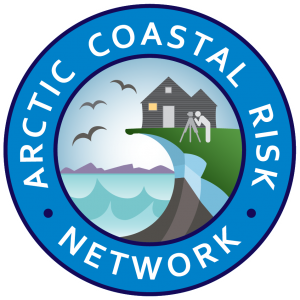 This Research Coordination Network (ANCHOR) will integrate social science, natural science, and engineering to address the imminent challenges that coastal communities in the Alaskan Arctic face due to rapid permafrost thaw and coastal erosion. These processes are causing buildings, roads, and areas of cultural significance to be undermined as coastlines subside and collapse into the sea. These communities are considering a range of options, which include abandoning their homelands for higher ground or building seawalls to limit erosion. At the same time, opportunities
This Research Coordination Network (ANCHOR) will integrate social science, natural science, and engineering to address the imminent challenges that coastal communities in the Alaskan Arctic face due to rapid permafrost thaw and coastal erosion. These processes are causing buildings, roads, and areas of cultural significance to be undermined as coastlines subside and collapse into the sea. These communities are considering a range of options, which include abandoning their homelands for higher ground or building seawalls to limit erosion. At the same time, opportunities Climate change is increasing vulnerability of Arctic urban communities to natural hazards such as unstable permafrost, wildfire, and rain-in-winter events. These hazards put residents and property at risk and impose economic costs, and households, businesses, and governments must adapt to these interacting hazards. This research is developing detailed maps showing how the occurrence of these three natural hazards has evolved simultaneously in the Municipality of Anchorage and the Fairbanks North Star Borough, Alaska, and Whitehorse, Yukon, Canada over the past several
Climate change is increasing vulnerability of Arctic urban communities to natural hazards such as unstable permafrost, wildfire, and rain-in-winter events. These hazards put residents and property at risk and impose economic costs, and households, businesses, and governments must adapt to these interacting hazards. This research is developing detailed maps showing how the occurrence of these three natural hazards has evolved simultaneously in the Municipality of Anchorage and the Fairbanks North Star Borough, Alaska, and Whitehorse, Yukon, Canada over the past several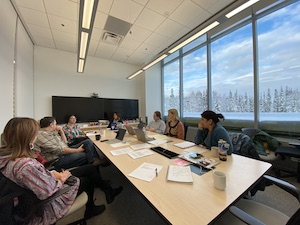
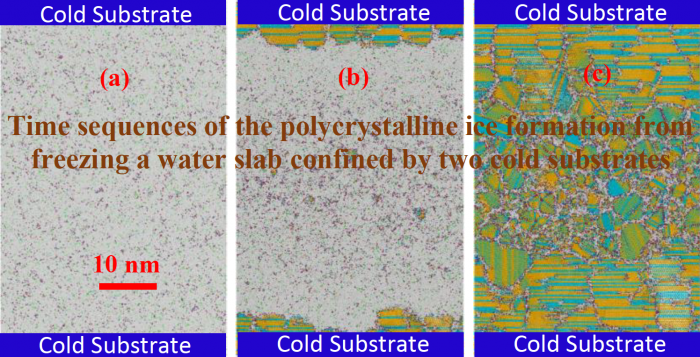
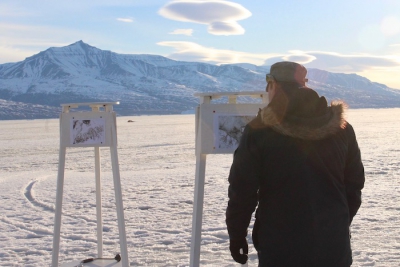 Shorefast ice (also known as landfast ice) is sea-ice that is attached to the coastline. Since it does not drift with the winds and currents, shorefast ice forms an important habitat for wildlife and a platform for human subsistence food production and transport in the Arctic. As the climate warms, residents local to the Arctic report that it is breaking up earlier in the year and is thinner than it was a few decades ago. These environmental changes threaten the sustainability of wildlife and traditional human activities that depend on shorefast ice. Despite its
Shorefast ice (also known as landfast ice) is sea-ice that is attached to the coastline. Since it does not drift with the winds and currents, shorefast ice forms an important habitat for wildlife and a platform for human subsistence food production and transport in the Arctic. As the climate warms, residents local to the Arctic report that it is breaking up earlier in the year and is thinner than it was a few decades ago. These environmental changes threaten the sustainability of wildlife and traditional human activities that depend on shorefast ice. Despite its The Permafrost Coastal Erosion-RCN (PCE-RCN) will bring together leaders in fields of natural and social science and engineering to address the challenges faced by coastal communities in the Arctic due to rapid coastal erosion. Rapid coastal erosion can force communities to consider moving inland and limit access to resources. One goal of the proposed PCE-RCN will be to better understand the challenges associated with coastal erosion, which is driven by permafrost thaw and changing sea ice conditions. Another goal is to identify potential solutions and their socio
The Permafrost Coastal Erosion-RCN (PCE-RCN) will bring together leaders in fields of natural and social science and engineering to address the challenges faced by coastal communities in the Arctic due to rapid coastal erosion. Rapid coastal erosion can force communities to consider moving inland and limit access to resources. One goal of the proposed PCE-RCN will be to better understand the challenges associated with coastal erosion, which is driven by permafrost thaw and changing sea ice conditions. Another goal is to identify potential solutions and their socio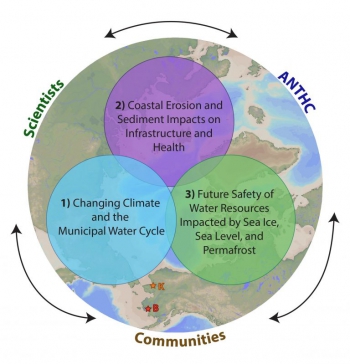
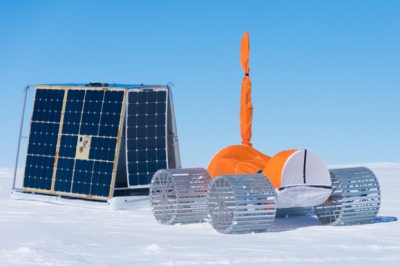 This research project seeks fundamental understanding of the dynamics of wheeled vehicles moving through soft terrain such as snow and sand. The project will derive models of movement that incorporate improved descriptions of interactions between the wheels and the ground. These innovative models will allow the treatment of, for example, lightweight vehicles and easily crumbled terrain. These models will allow the robot to predict when it is in danger of getting irrevocably stuck. New model-based control techniques will then allow the robot to avoid this danger, for
This research project seeks fundamental understanding of the dynamics of wheeled vehicles moving through soft terrain such as snow and sand. The project will derive models of movement that incorporate improved descriptions of interactions between the wheels and the ground. These innovative models will allow the treatment of, for example, lightweight vehicles and easily crumbled terrain. These models will allow the robot to predict when it is in danger of getting irrevocably stuck. New model-based control techniques will then allow the robot to avoid this danger, for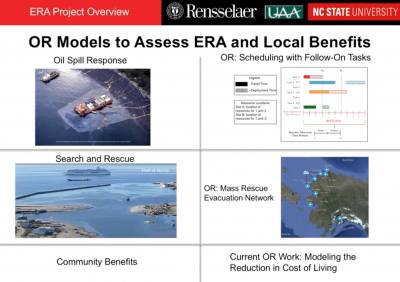 The Arctic has been experiencing significantly longer ice-free, navigable maritime seasons, thereby changing the types of activities taking place in Arctic waters. Cruise ships are travelling through the Northwest Passage, oil exploration is occurring off the North Slope of Alaska, and the Northern Sea Route is seeing an increasing volume of cargo ships travelling through it. In Arctic Alaska, these tourism and industrial activities will occur far away from the infrastructure and resources of urban and industrial centers, limiting response capabilities when an emergency
The Arctic has been experiencing significantly longer ice-free, navigable maritime seasons, thereby changing the types of activities taking place in Arctic waters. Cruise ships are travelling through the Northwest Passage, oil exploration is occurring off the North Slope of Alaska, and the Northern Sea Route is seeing an increasing volume of cargo ships travelling through it. In Arctic Alaska, these tourism and industrial activities will occur far away from the infrastructure and resources of urban and industrial centers, limiting response capabilities when an emergency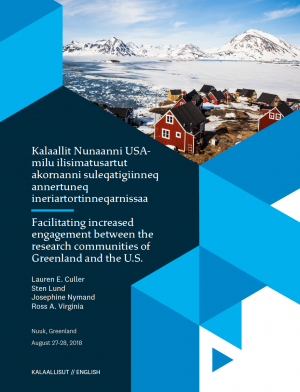 Greenland is an important research site for scientists from around the world. Because of its unique physical environment and geographic location between North America and Europe, the United States has a significant research presence in Greenland. This presence provides opportunities to strengthen bilateral cooperation with the research community of Greenland. At the ''Facilitating Engagement'' workshop, leading Arctic researchers from the US and Greenland will discuss and develop guidelines and frameworks for cooperative work, including knowledge co-production, community
Greenland is an important research site for scientists from around the world. Because of its unique physical environment and geographic location between North America and Europe, the United States has a significant research presence in Greenland. This presence provides opportunities to strengthen bilateral cooperation with the research community of Greenland. At the ''Facilitating Engagement'' workshop, leading Arctic researchers from the US and Greenland will discuss and develop guidelines and frameworks for cooperative work, including knowledge co-production, community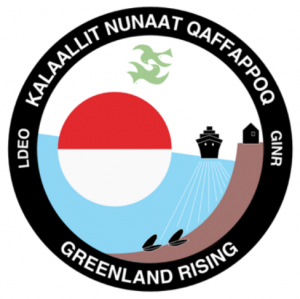 As ice melts around the world, sea level is projected to rise in many places and fall in others. Because Greenland is very close to the changing ice, it is anticipated that the land will rise, and that sea level will fall, impacting both humans, marine life, and natural resources. Community responses to changing sea level depend on accurate, location-specific knowledge of the present-day coastal environment and how it is predicted to change. Given the economic, mining, natural resources, and infrastructure development occurring in the Arctic, there is an urgent need to
As ice melts around the world, sea level is projected to rise in many places and fall in others. Because Greenland is very close to the changing ice, it is anticipated that the land will rise, and that sea level will fall, impacting both humans, marine life, and natural resources. Community responses to changing sea level depend on accurate, location-specific knowledge of the present-day coastal environment and how it is predicted to change. Given the economic, mining, natural resources, and infrastructure development occurring in the Arctic, there is an urgent need to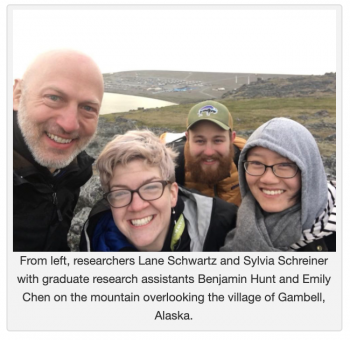 One locus of crosslinguistic variation in how languages build words is whether meaning is encoded in free morphemes (units of meaning) that stand alone as words, or whether those morphemes must combine with other morphemes to become words. While English has many free morphemes, the Alaska Native language, St. Lawrence Island/Siberian Yupik, uses the second strategy with very complex words, often sentence-sized. These properties are known as agglutination and polysynthesis. Researchers will document critical structures in the language, digitize existing Yupik materials
One locus of crosslinguistic variation in how languages build words is whether meaning is encoded in free morphemes (units of meaning) that stand alone as words, or whether those morphemes must combine with other morphemes to become words. While English has many free morphemes, the Alaska Native language, St. Lawrence Island/Siberian Yupik, uses the second strategy with very complex words, often sentence-sized. These properties are known as agglutination and polysynthesis. Researchers will document critical structures in the language, digitize existing Yupik materials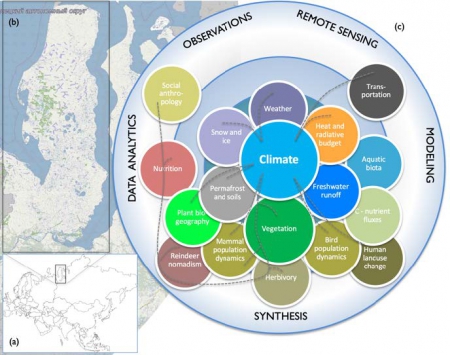 This project will bring together earth system scientists, engineers, ecologists, and anthropologists to develop a plan to document and explain changes in ecosystems and their effects on the plants, animals, indigenous peoples, and industrial infrastructure of the Arctic region. It will emphasize interactions between these elements to help understand, inform, and plan for changes to come. Researchers will focus on the Yamal Peninsula, which presents a continuous gradation of habitat types from forest in the south to tundra in the north, a rich diversity of endemic and
This project will bring together earth system scientists, engineers, ecologists, and anthropologists to develop a plan to document and explain changes in ecosystems and their effects on the plants, animals, indigenous peoples, and industrial infrastructure of the Arctic region. It will emphasize interactions between these elements to help understand, inform, and plan for changes to come. Researchers will focus on the Yamal Peninsula, which presents a continuous gradation of habitat types from forest in the south to tundra in the north, a rich diversity of endemic and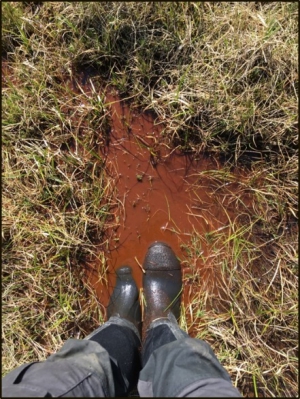 There is great concern about changing conditions in the Arctic due to environmental transformations that are impacting tundra and its underlying permafrost. At the same time, there are major gaps in our understanding of tundra/permafrost microbiology and elemental cycling. Filling these knowledge gaps will enable a better overall understanding of the tundra, and can provide crucial information about how this globally important, but fragile ecosystem will respond to change. The particular knowledge gap this research will fill centers around iron and the bacteria that
There is great concern about changing conditions in the Arctic due to environmental transformations that are impacting tundra and its underlying permafrost. At the same time, there are major gaps in our understanding of tundra/permafrost microbiology and elemental cycling. Filling these knowledge gaps will enable a better overall understanding of the tundra, and can provide crucial information about how this globally important, but fragile ecosystem will respond to change. The particular knowledge gap this research will fill centers around iron and the bacteria that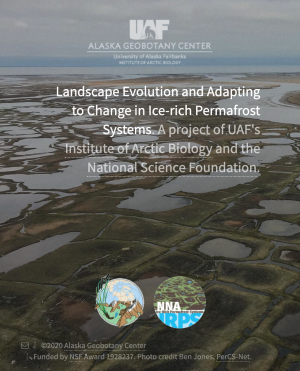 Ice-rich permafrost is ground that is frozen all year round for two or more years and contains particularly large amounts of water that will be released upon thawing. This ice is the element of Arctic landscapes most susceptible to climate warming. Nearly 50% of the Arctic has ice-rich permafrost. For example, the upper 4-5 meters of the land along Alaska's northern coast contains an estimated 77% ice. Thawing of ice-rich permafrost affects entire arctic ecosystems and makes the ground unstable to build upon. Thus, ice-rich permafrost is conceived as having a role similar
Ice-rich permafrost is ground that is frozen all year round for two or more years and contains particularly large amounts of water that will be released upon thawing. This ice is the element of Arctic landscapes most susceptible to climate warming. Nearly 50% of the Arctic has ice-rich permafrost. For example, the upper 4-5 meters of the land along Alaska's northern coast contains an estimated 77% ice. Thawing of ice-rich permafrost affects entire arctic ecosystems and makes the ground unstable to build upon. Thus, ice-rich permafrost is conceived as having a role similar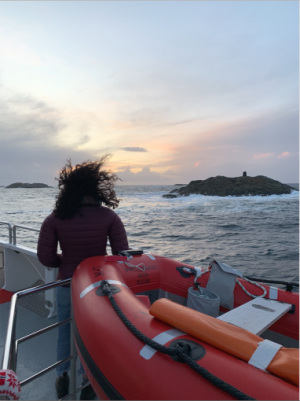 Warming in the Arctic has occurred at more than twice the global average, with negative impacts on ecosystems, wildfires, infrastructure, and Indigenous livelihoods. At the same time, this "Arctic amplification" may yield potentially positive impacts on some Arctic industries, such as shipping. Estimates of sea-ice extent project an ice-free Arctic over the next century, but more near-term projections are uncertain, notably increasing the risk (and required return) of investments in shipping infrastructure. Despite this uncertainty and the attendant risks, early
Warming in the Arctic has occurred at more than twice the global average, with negative impacts on ecosystems, wildfires, infrastructure, and Indigenous livelihoods. At the same time, this "Arctic amplification" may yield potentially positive impacts on some Arctic industries, such as shipping. Estimates of sea-ice extent project an ice-free Arctic over the next century, but more near-term projections are uncertain, notably increasing the risk (and required return) of investments in shipping infrastructure. Despite this uncertainty and the attendant risks, early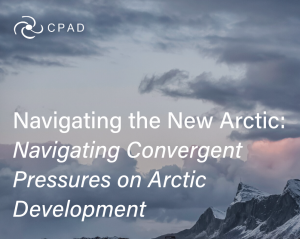 Few transformations are as dramatic or as complex as those occurring now in the Arctic. There are rapid changes in climate and the environment, in international treaties and regulations, in national security, and claims for territory. At the same time, Arctic communities and Indigenous Peoples are looking to find their place in a changing global economy. This convergence of changes and aspirations is leading to questions about what kinds of infrastructure are needed, where it should be located, and how this may impact Arctic people and environment. This project is using a
Few transformations are as dramatic or as complex as those occurring now in the Arctic. There are rapid changes in climate and the environment, in international treaties and regulations, in national security, and claims for territory. At the same time, Arctic communities and Indigenous Peoples are looking to find their place in a changing global economy. This convergence of changes and aspirations is leading to questions about what kinds of infrastructure are needed, where it should be located, and how this may impact Arctic people and environment. This project is using a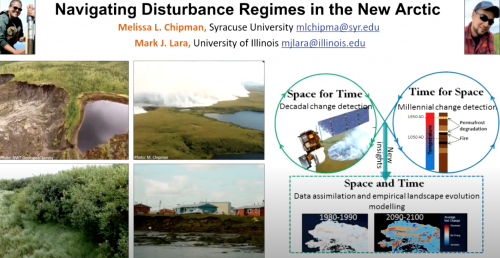 The Arctic has experienced unprecedented warmth over the past several decades. These areas have also experienced increased disturbances due to wildfires, permafrost degradation, and shrub expansion. Evidence suggests dynamic interactions and feedbacks exist among Arctic disturbance regimes. However, the interdependence of these disturbances makes quantifying their impact challenging. Overcoming this challenge is the first step in improving our capacity to predict future disturbance regimes in the face of climate change. To achieve this goal, researchers will evaluate the
The Arctic has experienced unprecedented warmth over the past several decades. These areas have also experienced increased disturbances due to wildfires, permafrost degradation, and shrub expansion. Evidence suggests dynamic interactions and feedbacks exist among Arctic disturbance regimes. However, the interdependence of these disturbances makes quantifying their impact challenging. Overcoming this challenge is the first step in improving our capacity to predict future disturbance regimes in the face of climate change. To achieve this goal, researchers will evaluate the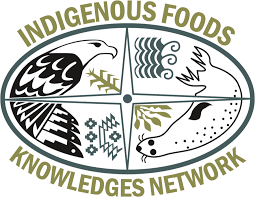 This project has been renamed the Indigenous Foods Knowledges Network (IFKN). This award supports a Research Coordinating Network (RCN) that brings together scientists and Indigenous communities, Alaska Native communities and Tribal communities in the US Southwest, to advance understanding of the challenges rapid socioecological change pose to food security and resilience in these communities. Indigenous knowledge and perspectives will be combined with scientific knowledge across the biological, geological, geographic, anthropological, and information sciences to enable a
This project has been renamed the Indigenous Foods Knowledges Network (IFKN). This award supports a Research Coordinating Network (RCN) that brings together scientists and Indigenous communities, Alaska Native communities and Tribal communities in the US Southwest, to advance understanding of the challenges rapid socioecological change pose to food security and resilience in these communities. Indigenous knowledge and perspectives will be combined with scientific knowledge across the biological, geological, geographic, anthropological, and information sciences to enable a The Pacific sector of the Arctic Ocean is warming, in particular the shallow Chukchi Sea. As a result, many organisms may spread into Arctic waters, and some present significant threats to human and ecosystem health, such as harmful algal bloom (HAB) species (commonly called red tides). The investigators present evidence that HABs occur in the Chukchi Sea and we know that the potent neurotoxins they produce can affect marine mammals, seabirds, and other resources critical to subsistence harvesters. At the same time, little is known about the present and future risk from
The Pacific sector of the Arctic Ocean is warming, in particular the shallow Chukchi Sea. As a result, many organisms may spread into Arctic waters, and some present significant threats to human and ecosystem health, such as harmful algal bloom (HAB) species (commonly called red tides). The investigators present evidence that HABs occur in the Chukchi Sea and we know that the potent neurotoxins they produce can affect marine mammals, seabirds, and other resources critical to subsistence harvesters. At the same time, little is known about the present and future risk from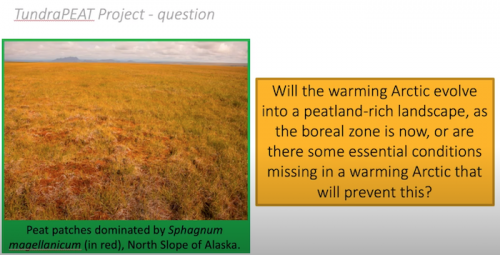 Amplified Arctic warming in recent decades has caused a multitude of changes in terrestrial ecosystems that have potential for strong feedbacks to the global system. Arctic vegetation greening may not necessarily result in increases in carbon sequestration in Arctic tundra due to complex and uncertain soil processes. Arctic tundra tends to have a thicker organic soil horizon (peat) than most other zonal biomes; research shows that peatlands comprise a sustained carbon sink. If shallow peatlands are widespread throughout the Arctic, the overall net carbon storage capacity
Amplified Arctic warming in recent decades has caused a multitude of changes in terrestrial ecosystems that have potential for strong feedbacks to the global system. Arctic vegetation greening may not necessarily result in increases in carbon sequestration in Arctic tundra due to complex and uncertain soil processes. Arctic tundra tends to have a thicker organic soil horizon (peat) than most other zonal biomes; research shows that peatlands comprise a sustained carbon sink. If shallow peatlands are widespread throughout the Arctic, the overall net carbon storage capacity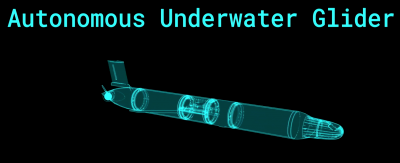 This project advances the national health, prosperity, and welfare by developing and demonstrating a new robotic technology for persistent, autonomous observation of under-ice marine environments over large (>1000 km) spatial scales. The Arctic is undergoing rapid change, with dramatic shifts in the sea ice cover and upper ocean. Monitoring and understanding these changes is critical to improving our ability to predict ongoing change and variability on seasonal-to-decadal timescales. Current observational capabilities are severely hampered by the logistical challenges of
This project advances the national health, prosperity, and welfare by developing and demonstrating a new robotic technology for persistent, autonomous observation of under-ice marine environments over large (>1000 km) spatial scales. The Arctic is undergoing rapid change, with dramatic shifts in the sea ice cover and upper ocean. Monitoring and understanding these changes is critical to improving our ability to predict ongoing change and variability on seasonal-to-decadal timescales. Current observational capabilities are severely hampered by the logistical challenges of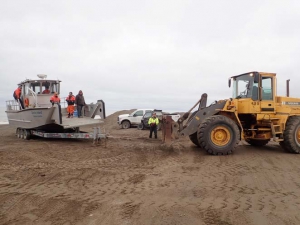 This project is taking a unique approach to investigating what is needed to enable subsistence communities in the Arctic to remain sustainable in the future, questioning the common assumption that climate impacts and sea ice loss are the most important challenges impacting subsistence activities in the Arctic. The group will broadly consider a set of interconnected factors and feedbacks, including changing culture, technology, economics, and governance in addition to climate. The proposal includes a clear plan to integrate co-production of knowledge and to capture the
This project is taking a unique approach to investigating what is needed to enable subsistence communities in the Arctic to remain sustainable in the future, questioning the common assumption that climate impacts and sea ice loss are the most important challenges impacting subsistence activities in the Arctic. The group will broadly consider a set of interconnected factors and feedbacks, including changing culture, technology, economics, and governance in addition to climate. The proposal includes a clear plan to integrate co-production of knowledge and to capture the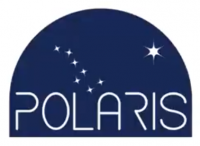 Alaskan coastal Indigenous communities face severe, urgent, and complex social and infrastructural challenges resulting from environmental changes. Coastlines are degrading and this impacts infrastructure that communities use on a daily basis, changing how people access and hunt for food and other natural resources and conduct their lives. The magnitude and significance of impacts are unclear as is how local communities will respond to resulting disruptions and disasters. A major problem facing researchers, stakeholders, and policymakers in addressing these issues is that
Alaskan coastal Indigenous communities face severe, urgent, and complex social and infrastructural challenges resulting from environmental changes. Coastlines are degrading and this impacts infrastructure that communities use on a daily basis, changing how people access and hunt for food and other natural resources and conduct their lives. The magnitude and significance of impacts are unclear as is how local communities will respond to resulting disruptions and disasters. A major problem facing researchers, stakeholders, and policymakers in addressing these issues is that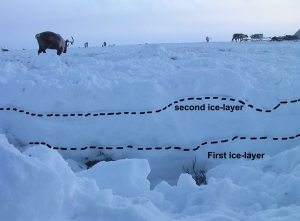 Rain on Snow (ROS) and extreme precipitation events have significant impacts on Arctic wildlife, livestock, and the communities that depend on these resources for subsistence. The icy crusts that form after ROS events and deep snow can interfere with travel and searching for food. ROS events have been linked to massive die-offs of reindeer and caribou. Polar bear and ringed seal populations are also affected--rains early in the breeding season destroy dens built under the snow and increase cub/pup mortality. The purpose of this study is to better understand the frequency
Rain on Snow (ROS) and extreme precipitation events have significant impacts on Arctic wildlife, livestock, and the communities that depend on these resources for subsistence. The icy crusts that form after ROS events and deep snow can interfere with travel and searching for food. ROS events have been linked to massive die-offs of reindeer and caribou. Polar bear and ringed seal populations are also affected--rains early in the breeding season destroy dens built under the snow and increase cub/pup mortality. The purpose of this study is to better understand the frequency Changes in Arctic sea ice have wide-ranging societal and ecological impacts. The opening of northern shipping routes, reliability of ice roads for access to coastal communities, and extraction of undersea resources have economic implications for countries around the world. Indigenous peoples depend on local marine mammal populations as a source of cultural and nutritional value, however Arctic marine mammals are particularly vulnerable to reductions in sea ice cover as have been occurring for more than 30 years. The presence and extent of Arctic sea ice can also influence
Changes in Arctic sea ice have wide-ranging societal and ecological impacts. The opening of northern shipping routes, reliability of ice roads for access to coastal communities, and extraction of undersea resources have economic implications for countries around the world. Indigenous peoples depend on local marine mammal populations as a source of cultural and nutritional value, however Arctic marine mammals are particularly vulnerable to reductions in sea ice cover as have been occurring for more than 30 years. The presence and extent of Arctic sea ice can also influence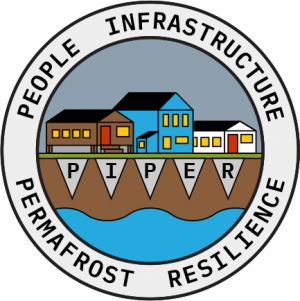 Temperatures in the Arctic are rising rapidly, and these warmer temperatures have caused permafrost, ground that remains frozen for at least two consecutive years, to warm and thaw. Permafrost coasts, which make up approximately 30% of the world's coastlines, are experiencing accelerated erosion due to thawing. Erosion at some locations has occurred at the rate of 16 m per year since 2007. Degradation of permafrost and related coastal erosion damages coastal infrastructure and facilities across the Arctic, impacting the economic prosperity and lives of its inhabitants
Temperatures in the Arctic are rising rapidly, and these warmer temperatures have caused permafrost, ground that remains frozen for at least two consecutive years, to warm and thaw. Permafrost coasts, which make up approximately 30% of the world's coastlines, are experiencing accelerated erosion due to thawing. Erosion at some locations has occurred at the rate of 16 m per year since 2007. Degradation of permafrost and related coastal erosion damages coastal infrastructure and facilities across the Arctic, impacting the economic prosperity and lives of its inhabitants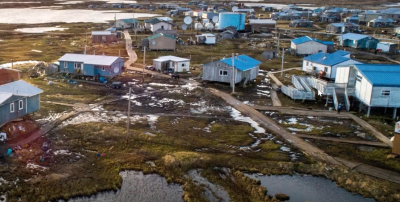 The housing conditions of Alaska Natives are significantly less developed compared to other parts of the United States. Such conditions result in poorer ventilation and indoor air quality, both of which negatively impact the health of the occupants. Additionally, housing durability is threatened by biophysical changes occurring as a result of climate change-driven permafrost thaw and erosion. The combination of issues that threaten household health emphasizes the critical need to consider housing risks and solutions using a holistic research methodology that rely on
The housing conditions of Alaska Natives are significantly less developed compared to other parts of the United States. Such conditions result in poorer ventilation and indoor air quality, both of which negatively impact the health of the occupants. Additionally, housing durability is threatened by biophysical changes occurring as a result of climate change-driven permafrost thaw and erosion. The combination of issues that threaten household health emphasizes the critical need to consider housing risks and solutions using a holistic research methodology that rely on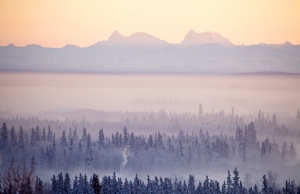 The cold and dark wintertime conditions of the Arctic lead to frequent poor air quality episodes linked to local emissions along with temperature inversions that trap pollutants in the areas where people live. Infrastructure planning such as energy generation and industrial activities along with residential choices of heating fuels such as wood, fuel oil or others are critical aspects of this problem. Residents spend most of their time indoors during wintertime, so most exposure to pollutants occurs indoors. From this background, fundamental knowledge gaps were identified
The cold and dark wintertime conditions of the Arctic lead to frequent poor air quality episodes linked to local emissions along with temperature inversions that trap pollutants in the areas where people live. Infrastructure planning such as energy generation and industrial activities along with residential choices of heating fuels such as wood, fuel oil or others are critical aspects of this problem. Residents spend most of their time indoors during wintertime, so most exposure to pollutants occurs indoors. From this background, fundamental knowledge gaps were identified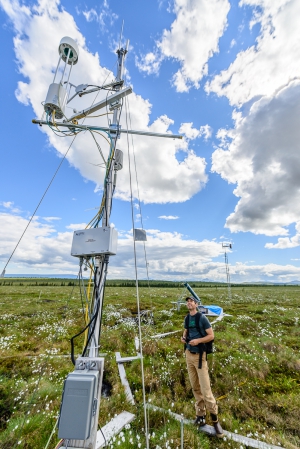 The future trajectory of Earth's atmosphere depends on the response of land and ocean to a changing environment, especially the potential for substantial sustained carbon release in high latitude regions like the Arctic. A key question in understanding how the Earth system will respond is whether there are tipping points—global carbon cycle surprises—that will make the effects of environmental change such as sea-level rise, extreme weather, droughts, and impacts on agriculture occur faster than currently projected by models. Permafrost carbon, the remnants of plants
The future trajectory of Earth's atmosphere depends on the response of land and ocean to a changing environment, especially the potential for substantial sustained carbon release in high latitude regions like the Arctic. A key question in understanding how the Earth system will respond is whether there are tipping points—global carbon cycle surprises—that will make the effects of environmental change such as sea-level rise, extreme weather, droughts, and impacts on agriculture occur faster than currently projected by models. Permafrost carbon, the remnants of plants The permafrost (perennially frozen ground) regions occupy nearly a quarter of the Earth's terrestrial surface. Permafrost is experiencing large changes stemming from the unprecedented degree of environmental change being observed in the Arctic. Changes in the permafrost system have profound effects on the ecology, hydrology, geomorphology, and human occupation of cold environments. The main indicators of permafrost stability are permafrost temperature and thickness of the active-layer (layer of earth materials between the ground surface and the top of the permafrost that
The permafrost (perennially frozen ground) regions occupy nearly a quarter of the Earth's terrestrial surface. Permafrost is experiencing large changes stemming from the unprecedented degree of environmental change being observed in the Arctic. Changes in the permafrost system have profound effects on the ecology, hydrology, geomorphology, and human occupation of cold environments. The main indicators of permafrost stability are permafrost temperature and thickness of the active-layer (layer of earth materials between the ground surface and the top of the permafrost that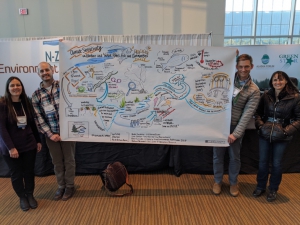 Northern communities in Alaska and Canada rely upon productive fisheries. For many of these communities, rivers are used to access fishing and hunting grounds and to transport supplies during ice-free seasons and over river-ice in winter. As the Arctic and its rivers continue to warm, the ultimate impacts on people, their fisheries and winter travel corridors are highly uncertain. Improved understanding of the ongoing and possible future changes requires close partnership among Native groups and researchers from diverse scientific disciplines. This project is a
Northern communities in Alaska and Canada rely upon productive fisheries. For many of these communities, rivers are used to access fishing and hunting grounds and to transport supplies during ice-free seasons and over river-ice in winter. As the Arctic and its rivers continue to warm, the ultimate impacts on people, their fisheries and winter travel corridors are highly uncertain. Improved understanding of the ongoing and possible future changes requires close partnership among Native groups and researchers from diverse scientific disciplines. This project is a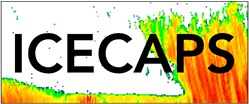 The Greenland Ice Sheet is a unique location in the Arctic. It rises from sea level to over 10,000 feet in elevation and is, by far, the largest topographic feature north of the Arctic Circle. Scientists have determined that the ice sheet is sensitive to climatic fluctuations. In spite of its uniqueness and importance, it is relatively under-studied compared to other locations on Earth. The Integrated Characterization of Energy, Clouds, Atmospheric state, and Precipitation at Summit (ICECAPS) project has been measuring properties of the surface and atmosphere over
The Greenland Ice Sheet is a unique location in the Arctic. It rises from sea level to over 10,000 feet in elevation and is, by far, the largest topographic feature north of the Arctic Circle. Scientists have determined that the ice sheet is sensitive to climatic fluctuations. In spite of its uniqueness and importance, it is relatively under-studied compared to other locations on Earth. The Integrated Characterization of Energy, Clouds, Atmospheric state, and Precipitation at Summit (ICECAPS) project has been measuring properties of the surface and atmosphere over Permafrost is ground that remains frozen for at least two consecutive years. It occurs under approximately one fourth of the northern hemisphere's land surface. In the far north, the permafrost is continuous across the landscape and contains large amounts of ice in its upper few meters. Thawing of permafrost has been observed at several locations across the Arctic in recent decades, yet the complete extent of permafrost degradation is not yet described. This is because it is difficult to directly measure permafrost. However, the presence and health of permafrost can be
Permafrost is ground that remains frozen for at least two consecutive years. It occurs under approximately one fourth of the northern hemisphere's land surface. In the far north, the permafrost is continuous across the landscape and contains large amounts of ice in its upper few meters. Thawing of permafrost has been observed at several locations across the Arctic in recent decades, yet the complete extent of permafrost degradation is not yet described. This is because it is difficult to directly measure permafrost. However, the presence and health of permafrost can be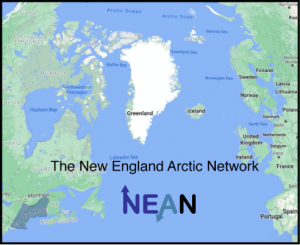 The rapid warming of the Arctic and melting of Arctic sea and land ice has ramifications around the globe. Shipping routes through an ice-free Arctic in combination with modifications to ocean circulation and regional climate patterns linked to Arctic ice melt affect trade, transportation, coastal ecology and hydrology, human-built infrastructure, demographics and cultural identities, fish and wildlife, energy resources, and air and water quality—not only in the Arctic but also in mid-latitude coastal regions such as New England. With profound changes on the horizon, now
The rapid warming of the Arctic and melting of Arctic sea and land ice has ramifications around the globe. Shipping routes through an ice-free Arctic in combination with modifications to ocean circulation and regional climate patterns linked to Arctic ice melt affect trade, transportation, coastal ecology and hydrology, human-built infrastructure, demographics and cultural identities, fish and wildlife, energy resources, and air and water quality—not only in the Arctic but also in mid-latitude coastal regions such as New England. With profound changes on the horizon, now The Unangam Ulaa is the traditional house of the Unangax people in the Aleutian Islands and Alaska Peninsula, typically constructed from sod and partially buried into the soil surface. This Navigating the New Arctic (NNA) grant supports a scientific investigation into the construction and design of the Unangam Ulaa to determine how ancient construction techniques can be adapted using modern materials to create energy efficient dwelling specifically designed for the Aleutians yet transferrable to other Arctic regions. This work will integrate ancient and modern expertise
The Unangam Ulaa is the traditional house of the Unangax people in the Aleutian Islands and Alaska Peninsula, typically constructed from sod and partially buried into the soil surface. This Navigating the New Arctic (NNA) grant supports a scientific investigation into the construction and design of the Unangam Ulaa to determine how ancient construction techniques can be adapted using modern materials to create energy efficient dwelling specifically designed for the Aleutians yet transferrable to other Arctic regions. This work will integrate ancient and modern expertise